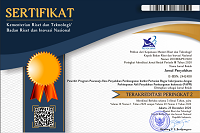Life Accentuation in Cognitive Dissonance and Hedonistic Behavior between Jakarta and Moscow Adolescents
Abstract
Information and communication technology play an important role in the development of communication, one of which is the utilization of the online shop platform, to fulfill the desire for a hedonistic lifestyle. The changes in lifestyle focus on seeking unlimited pleasure and satisfaction. Life accentuation assumes that a person will feel happy by seeking happiness and avoiding feelings of pain, disappointment, and sadness. The research objective was to compare Jakarta and Moscow adolescents' cognitive dissonance and hedonism behavior. The comparative descriptive quantitative research method was used on 101 Moscow teenage respondents and 102 Jakarta respondents using cognitive dissonance theory and behavioral theory. The results were (1) ‘Looking for unlimited pleasure and satisfaction’ is ‘often’ (54.10%) by Jakarta teenagers, higher than Moscow teenagers (only 39.40%), and ‘sometimes’ (52.10%). (2) The dimension of ‘seeking as much happiness as possible and avoiding painful feelings’, Jakarta teenagers are 45.90% while Moscow teenagers are 36.60%, and ‘sometimes’ (56.30%). (3). For the dimensions of ‘seeking happiness symbolically’, Jakarta teenagers are more ‘often’ (53.10%) than Moscow teenagers (36.60%) and ‘sometimes’ (52.10%). (4) In the dimension of ‘pleasure is the most important thing in life’ there are differences between teenagers in Moscow and teenagers in Jakarta (54.10%) and Moscow teenagers are ‘often’ (63.40%) lower and ‘sometimes’ tend to behave hedonistically (63.40%).
Downloads
References
Abdullah, L. (2019). Apa Pendapat Mereka tentang Hedonisme di Kalangan Anak Muda?". Yong Loo Lin School of Medicine National University of Singapore (NUS).
Anggraini, R. T., & Santhoso, F. H. (2019). Hubungan antara Gaya Hidup Hedonis dengan Perilaku Konsumtif pada Remaja. Gadjah Mada Journal of Psychology (GamaJoP), 3(3), 131. https://doi.org/10.22146/gamajop.44104
Asih, Tresna, C., & Hadiyanto. (2016). Hubungan Antara Pola Menonton Sinetron Dengan Gaya Hidup Hedonisme Remaja Pedesaan. Http://Repository.Ipb.Ac.Id/Handle/123456789/81924.
Azzarah, P. N. A., & Aisyah, S. B. (2019). Perilaku Hedonisme Mahasiswa Di Trans Studio Mall Makassar. Jurnal Berita Sosial, 9(2).
Brilliandita, A., & Putrianti, F. G. (2017). Hubungan Antara Konsep Diri Dengan Kecenderungan Gaya Hidup Hedonisme Pada Mahasiswi Psikologi Ust Yogyakarta. Jurnal Spirits, 5(2), 45. https://doi.org/10.30738/spirits.v5i2.1065
Chaney, D. (1996). Sebuah Pengantar Komprehensif . Jalasutra.
Fitriyani, N., Widodo, B., & Fauziah, N. (2013). Hubungan Antara Konformitas Dengan Perilaku Konsumtif Pada Mahasiswa Di Genuk Indah Semarang. https://doi.org/doi:10.14710/jpu.12.1.1-14
Gushevinalti. (2010). Telaah kritis perspektif Jean Baudrilard pada perilaku hedonisme remaja. Jurnal Idea Fisipol UMB. Jurnal IDEA FISIPOL UMB, 4(14), 1–86.
Jennyya, V., Pratiknjo, M. H., & Rumampuk, S. (2021). Gaya Hidup Hedonisme Di Kalangan Mahasiswa Universitas Sam Ratulangi (Vol. 14, Issue 3).
Kirgiz, A. (2014). Hedonism, A Consumer Disease Of The Modern Age: Gender And Hedonic Shopping In Turkey. Global Media Journal, 4(8).
Kotler, Philip. (2010). Manajemen Pemasaran. Edisi tiga belas Bahasa Indonesia. Jilid 1 dan 2. Erlangga.
Kusumanugraha, C. (2003). Fenomena Gaya Hidup Hedonis pada Remaja. Fakultas Psikologi UNIKA.
Maulana, R. (2013, October 18). Remaja dan perilaku konsumtif. https://www.kompasiana.com/maulan aridone/552a70ce6ea834ad6c552d01/remaja-dan-perilaku-konsumtif
Melati, Damayanti, I. P., Faizuddin. A, Mussyarop, N. F., & Yuliyantu, N. (2022). Maraknya Budaya Hedonisme di Kalangan Remaja.
Naomi, P., & Mayasari, L. (2013). Faktor Faktor Yang Mempengaruhi Siswa Sma Dalam Perilaku Pembelian Kompulsif : Perspektif Psikologi. Perspektif Psikologi. Portal Jurnal UPI.
Nazarudin, H., & Widiastuti, T. (2022). Gaya Hidup Hedonisme dan Perilaku Konsumtif Remaja Putri Kota Kupang. Jurnal Ilmiah Aset, 24(1), 29–35. https://doi.org/10.37470/1.24.1.198
Nurvitria, A. L. (2015). Pengaruh Gaya Hidup Hedonis Terhadap Perilaku Pembelian Impulsif Pada Mahasiswa Jurusan PPB 2013 FIP UNY.
Nurwitasari. (2015). Pengaruh Religiusitas Dan Status Sosial Ekonomi Orang Tua Terhadap Gaya Hidup Hedonisme Pada Remaja. Jurnal Motivasi, 3(1).
Oswaldo, I. G. (2021). Gaya Hidup Hedonisme: Pengertian, Dampak, & Cara Mengatasinya.
Putri, N. K. D. J., Dewi, A. Y., Angela, N. A. T., & Hardika, I. R. (2019). Gaya Hidup Hedonisme Remaja di Kawasan Legian, Kabupaten Badung. Jurnal Psikologi MANDALA, 3(1), 29–52.
Ramadhan, A. F., & Simanjuntak, M. (2018). Perilaku Pembelian Hedonis Generasi Z: Promosi Pemasaran, Kelompok Acuan, dan Konsep Diri. Jurnal Ilmu Keluarga Dan Konsumen, 11(3), 243–254. https://doi.org/10.24156/jikk.2018.11.3.243
Resita, R. (2016). Perilaku Hedonisme Remaja Di Mall Panakukkang Makassar.
Rifqi. (2022). Mengenal Gaya Hidup Hedonisme. Pusat Jurnal Ilmiah Medan Area, 1(1), 1–5.
Santrock, J. W. (2012). Life span development edisi ke-13. Erlangga.
Sari, N. (2023). Pengaruh Sosial, Gaya Hidup, Dan Motivasi Belanja Hedonis Terhadap Perilakukonsumtif Mahasiswa Febi Uin Khas Jember Pengguna Fitur Spaylater. In 2018.
Setiadi, N. J. (2003). Perilaku Konsumen : Konsep dan Implikasi Untuk Strategi dan Penelitian Pemasaran. Kencana.
Solomon. (1996). Consumer behavior; buying, having, and being. Prentice - Hall International, Inc.
Sugiyono. (2018). Metode Penelitian Kuantitatif. Alfabeta.
Sukari, L., Mudjijono, & Susilantini, E. (2013). Perilaku Konsumtif Siswa SMA Di Daerah Istimewa Yogyakarta. BNPB.
Susana, E. (2016). Pengaruh Locus Of ControlTerhadap Gaya Hidup Hedonisme Pada Pegawai Negeri Sipil Di Sekeretariat Daerah Kota Samarinda.
Tambingon, J., Tasik, F. C. M., & Purwanto, A. (2018). Gaya Hidup Hedonisme Mahasiswa Fakultas Ekonomi Dan Bisnis Universitas Sam Ratulangi Di Kota Manado.
Authors who publish with this journal agree to the following terms:
- Authors retain copyright and grant the journal right of first publication with the work simultaneously licensed under a

This work is licensed under a Creative Commons Attribution 4.0 International License that allows others to share the work with an acknowledgement of the work's authorship and initial publication in this journal. - Authors are able to enter into separate, additional contractual arrangements for the non-exclusive distribution of the journal's published version of the work (e.g., post it to an institutional repository or publish it in a book), with an acknowledgement of its initial publication in this journal.
- Authors are permitted and encouraged to post their work online (e.g., in institutional repositories or on their website) prior to and during the submission process, as it can lead to productive exchanges, as well as earlier and greater citation of published work (See The Effect of Open Access).















